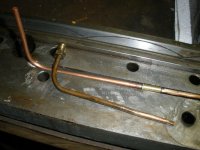Zahnrad Kopf
Diamond
- Joined
- Apr 5, 2010
- Location
- Tropic of Milwaukee
As usual, I have searched but not come up with good enough information so am asking here.
I am waiting for the opportunity to have the bed ground right now and think it might be a good time to rip the apron apart as well as get the saddle ready for Moglice application. Both tasks mean addressing the oil system. < shudder >
< shudder > 
So, after trying to search and read what other intrepid souls have done before me I notice that most of this info is now very, very old and possibly very outdated. What is the accepted best choice these days? Copper? Steel? What about Plastic lines? ( I believe they degrade with oil contact, but am not up to speed on them so think to ask. )
What about Stainless? It is no secret here on PM that I am a big fan of Stainless. From fasteners to tooling, it is one of my "go to" materials for longevity and appealing characteristics. So what about oil tubing in the 10EE? McMaster has it in 3/32" and 5/32", and it is even available in many differing wall thicknesses. ( .005", .010", .015", .020", .028" & .035" ) I am thinking that .015" ( or .010" ) might work well for some of the tighter, restrictive places, as well as make the duties of bending it a little easier than thick walled.
And what about other upgrades or modifications? There seems to be some lack of clarity on what eras/models oil the cross slide directly and which do not. Can it easily be made to do so after the fact, effectively upgrading the system?
And what of the manifold under the saddle? Has anyone come up with a decent way to remove as well as replace and bed them again?
Has anyone found reason to change the meters to other sizes, or found them to more useful? What about modifying the frequency by manner of the cam? Has anyone looked at adding some manner of manual actuation not requiring carriage traverse?
Thanks for any insights and experiences.
I am waiting for the opportunity to have the bed ground right now and think it might be a good time to rip the apron apart as well as get the saddle ready for Moglice application. Both tasks mean addressing the oil system.
 < shudder >
< shudder > 
So, after trying to search and read what other intrepid souls have done before me I notice that most of this info is now very, very old and possibly very outdated. What is the accepted best choice these days? Copper? Steel? What about Plastic lines? ( I believe they degrade with oil contact, but am not up to speed on them so think to ask. )
What about Stainless? It is no secret here on PM that I am a big fan of Stainless. From fasteners to tooling, it is one of my "go to" materials for longevity and appealing characteristics. So what about oil tubing in the 10EE? McMaster has it in 3/32" and 5/32", and it is even available in many differing wall thicknesses. ( .005", .010", .015", .020", .028" & .035" ) I am thinking that .015" ( or .010" ) might work well for some of the tighter, restrictive places, as well as make the duties of bending it a little easier than thick walled.
And what about other upgrades or modifications? There seems to be some lack of clarity on what eras/models oil the cross slide directly and which do not. Can it easily be made to do so after the fact, effectively upgrading the system?
And what of the manifold under the saddle? Has anyone come up with a decent way to remove as well as replace and bed them again?
Has anyone found reason to change the meters to other sizes, or found them to more useful? What about modifying the frequency by manner of the cam? Has anyone looked at adding some manner of manual actuation not requiring carriage traverse?
Thanks for any insights and experiences.


 But I appreciate where you're coming from. This is more a standard exercise for me. If I am forced to address something, it is a natural process for me to ask that as long as I have to "go in", if it could stand some manner of improvement. Speaking for only myself, it is along the lines of "Anything worth doing is worth doing well." I could likely make do with pasta noodles for tubing, but I may as well make sure that it lasts for the next owner of the machine, too.
But I appreciate where you're coming from. This is more a standard exercise for me. If I am forced to address something, it is a natural process for me to ask that as long as I have to "go in", if it could stand some manner of improvement. Speaking for only myself, it is along the lines of "Anything worth doing is worth doing well." I could likely make do with pasta noodles for tubing, but I may as well make sure that it lasts for the next owner of the machine, too.

